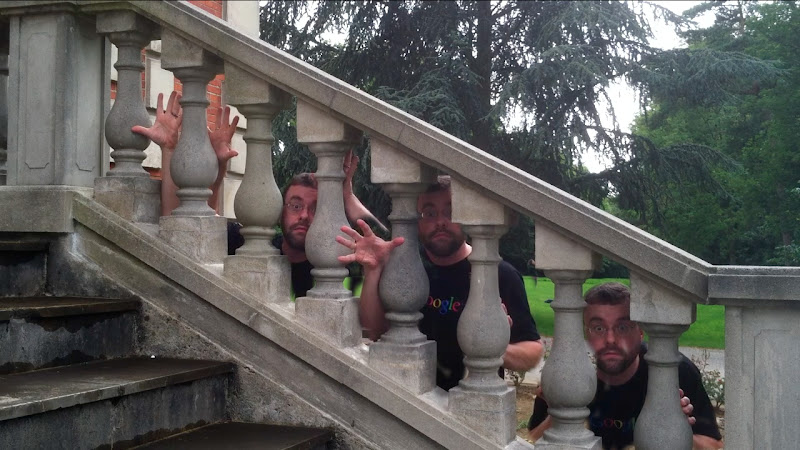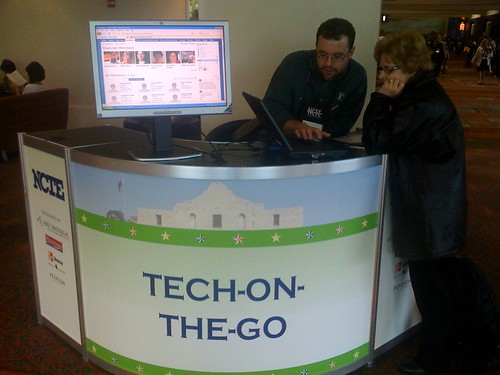As many of my colleagues participate this weekend in the #blog4nwp cooperative, I want to thank Chad Sansing and Pam Moran for coordinating the effort and for the dozens of teachers who are adding their voices to this important conversation about saving the National Writing Project.
At the same time, I hope that my voice offers a complementary, although slightly different perspective — the voice of a junior faculty member who is also a director of an NWP site. In an era where the liberal arts in general, teacher education, and school performance are continually scrutinized, and the value of all three are constantly in question, I hope that my perspective as someone from inside the “ivory tower,” someone who is in the business of educating educators, offers yet another reason why NWP must be funded.
To begin, I acknowledge that there are many stories that have been and will continue to be told this weekend about the value of NWP to our personal and professional lives, and the life-changing experience that an NWP summer institute offers. This is all very true from my experience, and I consider myself a teacher and a writer, for sure, because of my involvement in NWP.
In addition, I am also a young faculty member and scholar whose work — my teaching, scholarship, and service — has been shaped and focused by NWP. To that end, I need to say more about how and why NWP works. I say this to show that NWP is a positive force for change, and worthy of continued funding from the federal government.
Without NWP, I can say quite simply, I would have no work.
While this is not entirely true (as I would likely still be teaching methods courses, participating in conferences, and writing for publications without the NWP). Perhaps I should say that I would not have meaningful, worthwhile work, or, at the very least, I don’t know that much of that work would matter. My teaching, scholarship, and service are all defined in relation to my work with NWP. Without NWP, I truly don’t know that my work would be possible, at least not in the way that I imagine strong, quality professional learning to happen.
Why?
As a junior faculty member, my colleagues in NWP have helped me think through all of my responsibilities to teachers and the profession, and it has given me the collegial space in which I can try out teaching ideas, explore digital writing, and seek collaboration. NWP has given me the opportunity to travel the country, work with teachers, and understand their many different classroom contexts. The people with whom I have worked offer me ideas and inspiration to write more, think more, present more, and work diligently to change the way writing is taught in this country. NWP has allowed and encouraged me to write books and articles. At CMU, I have articulated a vision for teaching, scholarship, and service that centers on the idea of active engagement, all guided by the NWP philosophy. And, most importantly, as a young faculty member who is often confronted with pressures inside and outside the university about the value of a liberal education and sometimes forced to defend myself as a teacher of writing, NWP has offered me the strength to state, with conviction, my beliefs about teaching writing as a personal and social act that can lead to personal and professional growth, reflection, and action.
If Congress wants a liberal arts education to have value, putting universities in partnerships with local schools and community agencies, then its members should vote to keep the NWP.
If Congress wants teacher education and professional development to be timely, evidence-based, and instructive, then its members should vote to keep the NWP.
And if Congress wants to see changes in teacher practice that lead to student achievement, then its members should vote to keep the NWP.
Without NWP, yes, I would still be teaching, still be researching, and still be serving my university, community, and profession. Yet, I have to wonder… to what extent would my teaching just be average? Would my research be filed away in obscure journal? Would my service be limited to peer review of articles and serving on only small committees? Would I really be a teacher, a write, and a voice in the dialogue about education reform in this country without NWP?
I am not 100% sure. However, I can say unequivocally that NWP has helped me become the teacher, researcher, and leader I am today. NWP works not only because it is one of the most cost-effective and results-oriented educational programs ever conceived, but also because it puts so many stakeholders involved with education in conversation with one another. And, these conversations matter. In schools. In communities. And, in universities.
Case in point: This past Wednesday, I was awarded with CMU’s Provost Award for outstanding achievement in research and creative activity by a junior faculty member. I thank my family, friends, and colleagues, all of whom have contributed to me earning this honor, many of whom have NWP connections. And, now that I have been recognized by CMU with the Provost’s Award in large part because of NWP — and, more importantly, on the weekend that we are sharing our collective voice about the importance of NWP — I want to share the text of my personal statement that I wrote.
Congress, quite simply, I ask that you reallocate funds to the National Writing Project. It is an investment that will pay dividends that go far beyond dollars. My hope is that both this letter above and my personal statement shared below can contribute to this conversation.
Troy Hicks
Director, Chippewa River Writing Project
Personal Statement for CMU Provost’s Award
Troy Hicks, January 2011
Significance of scholarship can be measured in many ways, including acceptance rates for a journal or the number of citations a work generates. More importantly, given the increased scrutiny on the role of arts and humanities in a liberal education, measurements of significance can include grant dollars, credit hours, and public recognition beyond the university, including commendations and awards. These measures are, indeed, important, and my scholarship had earned significance in these ways.
Yet, as a public intellectual in a digital age, my work takes many forms, including traditional academic formats such as books, journal articles, grants, and conference presentations, as well as a scholarship of application that includes teacher research, workshops, webinars, and blogging. In turn, my scholarship is significant because it reaches a variety of audiences, from the local level at CMU to the larger field of K-16 education, affecting the ways that we teach and learn writing in a digital age.
In my work, I explore the ways in which teachers adapt writing instruction to newer literacies and technologies, an emerging field called “digital writing.” Thus, the nature of my work has been—and will continue to be—flexible and timely, connecting the rich history of research in composition studies to the ever-changing needs of my colleagues who are teaching a new generation what it means to write with pencil and paper, as well as with computers, mobile phones, and digital cameras. My thoughts on digital writing are summed up best in a recent interview for District Administration, in which I stated:
The shape of writing has changed… Kids are now writing for real audiences and for real purposes, not just other kids in the class or the refrigerator door. And they are composing on computers and on phones in text and multimedia. These are substantial changes.
At CMU, my scholarship has direct effects on the undergraduate and graduate students that I teach, most of whom are pre-service and in-service teachers. Because I explore how we can use technology to teach writing, I am constantly collaborating with colleagues to write grants, plan workshops, collect data, and analyze what is happening in their classrooms. Along with the undergraduate writing methods course that I teach, ENG 315, I have worked with CMU colleagues to establish our site of the National Writing Project, the Chippewa River Writing Project (CRWP). In 2009 and 2010, and again in this coming summer of 2011, we offer a four-week summer institute for K-16 teachers of writing. My scholarship moves immediately from the process of writing a grant to fund CRWP into a process of application where we work with teachers to improve their practice. For instance, the chapter I have included in my materials that I co-authored with Dawn Reed, “From the front of the classroom to the ears of the world: Podcasting as an extension of speech class,” is indicative of the types of teacher research projects that I develop with my colleagues through writing project work. At least nine teachers affiliated with CRWP have completed or are working on their own teacher research projects, including IRB protocols and systematic inquiry in their own classroom practice. I encourage teachers to engage in the research process, leading them to create conference presentations, journal articles, and book chapters. In short, my work at CMU with the CRWP is an applied form of scholarship, showing the importance of how we can study and teach the arts and humanities broadly, and writing in particular.
From the immediate effects on CMU’s campus, my work is significant in local, state, and national professional development, too. While teachers can often read about ways to integrate technology in their classroom, we know from research in teacher education that they need time for their own learning and reflective implementation of these plans. Thus, professional development must be timely and embedded in teacher practice, and I actively move my scholarship forward from the articles and books that I write into my relationships with teachers. This past year, I have collaborated with the Center for Excellence in Education to develop a Title II Professional Development grant, WRITE NOW, extending many of the ideas of that I write about in my work into workshops and literacy coaching for local teachers. For instance, my co-authored article “Transforming the group paper with collaborative online writing,” offers many examples for how teachers can invite their students to use technology to collaborate and revise. To enact this, in the summer of 2010 I led a five-day workshop for twenty local teachers to learn how to use these tools. Then, as a follow-up this year, I am working as a literacy coach in Mt. Pleasant High School and Oasis Alternative High School, helping teachers take the ideas that they learned and applying those ideas in their classrooms. Again, my work on this grant is scholarship in action, leading teachers as they examine research on digital writing and immediately applying it. These initiatives with teachers are where most of my day-to-day work happens, and it is through this process where change occurs, leading to significant effects for students in their classrooms.
The work that I do with these teachers in local contexts then leads to broader conversations that occur across the nation, beginning with the books that I write and continuing with the subsequent conference presentations, webinars, and workshops that I lead. For instance, my first book, The Digital Writing Workshop, has combined two areas of composition studies – writing workshop pedagogy and the study of digital writing – and solidified the use of the term “digital writing workshop” in the discourse of K-12 writing instruction. My approach to writing this book was one that would speak to writing teachers about pedagogy, not just offer a list of technology tools that they could use in their classroom. One review of the book summarized it in this manner: “Teachers’ fear and preoccupation over technology tends to feed an either/or dualism that sets teaching and technology against each other… Hicks avoids this pitfall. Instead, he portrays technology and writing as ‘intricately intertwined’ by keeping a firm hand on two visions.” Because of this approach, my book has been adopted by numerous National Writing Project sites and English education courses across the nation, and Heinemann began a second printing only eight months after its initial publication in September, 2009. As a result of this work, I have been invited over the past eighteen months to speak at over twenty professional conferences and workshops broadly related to English education and teacher education, as well as one invitation even to speak with an audience of school architects. I estimate that I have delivered over 10,000 contact hours of professional development, thus extending the reach of my scholarship well beyond traditional academic publications and conference presentations. Also, as a sign of the book’s effect on English Education, I was awarded National Technology Leadership Award in English Education from the Society for Information and Technology Education’s English Education Special Interest Group.
Along with classroom practices, I am interested in larger concerns about curriculum development, school policies, and infrastructures. My second book, Because Digital Writing Matters, released in November 2010, has already entered the discourse of K-12 education by influencing school district policies and curriculum design, as well as teaching practice. For instance, the Etowah County Schools in Alabama have recently adopted Because Digital Writing Matters as a text for their latest professional development initiative. As a co-author of the book, published jointly by the National Writing Project and Jossey-Bass, I am also involved as a “curator” of the new NWP website, “Digital Is,” a collection of multimedia resources created by teachers and students. As writing continues to change, I understand that the ways in which we share our scholarship needs to change, too, and online resources that complement traditional academic publications will be significant as educators create professional development initiatives nationwide.
As demonstrated in my work, there are many measures of significance—especially the effects that it has on teacher professional development and student learning—that matter as much or more than traditional measures of academic success. When I lead a workshop and have a teacher tell me that my work has changed the way that she teaches writing, that is significant. When I am compared by my peers to some of the historic leaders in the field of teaching writing, that is significant. When my work inspires others to do research, create workshops, and reflect on their own teaching, that is significant.
Significance can be measured in many ways and my work appeals to both traditional academic audiences and K-16 educators more broadly, thus changing the conversations about how we teach writing in our schools and contributing to a new line of scholarship that will last for decades to come.

This work is licensed under a
Creative Commons Attribution-Noncommercial-Share Alike 3.0 United States License.
Like this:
Like Loading...








